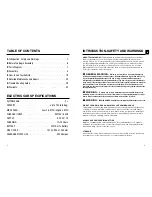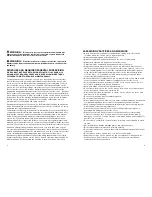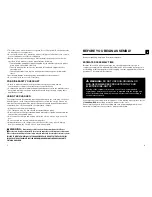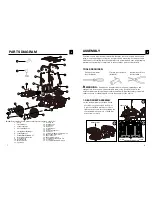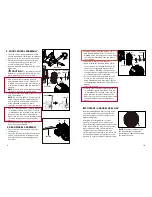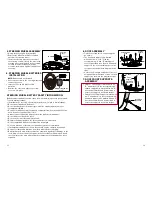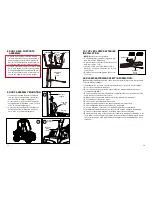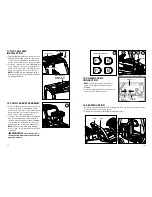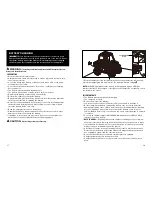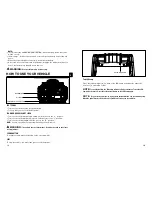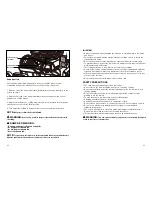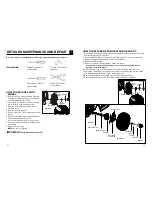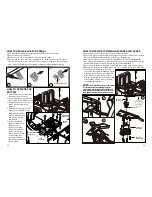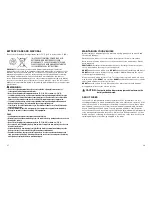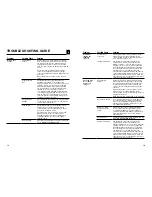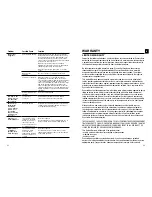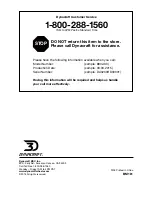
27
28
MAINTAINING YOUR VEHICLE
Occasionally use a lightweight oil to lubricate moving parts, such as wheels and
the steering linkages.
Park the vehicle indoors or cover it with a tarp to protect it from wet weather.
Keep the vehicle away from sources of heat, such as stoves and heaters. Plastic
parts may melt.
ADULTS ONLY:
Recharge the battery after each use. Recharge the battery at least
once a month when the vehicle is not being used.
DO NOT
wash the vehicle with a hose.
DO NOT
wash the vehicle with soap and water.
DO NOT
drive the vehicle in rainy or snowy weather. Water will damage the motor,
electrical system, and battery.
Clean the vehicle with a soft, dry cloth. To restore shine to plastic parts, use a non
wax furniture polish.
DO NOT
use car wax.
DO NOT
use abrasive cleaners, or cleaners
that contain ammonia or isopropyl alcohol.
DO NOT
drive the vehicle in loose dirt, sand or fine gravel, which could damage
moving parts, motors or the electric system.
CAUTION:
Charge the battery before storing your vehicle, otherwise the
battery will be damaged.
ABOUT FUSES
Your vehicle is equipped with a safety thermal fuse. The thermal fuse is a self-
resetting safety device which automatically “trips” and shuts down operation of the
vehicle if the vehicle is overloaded or the driving condition too severe. Once a fuse
has “tripped”, remove your foot from the pedal and wait approximately 2 minutes
before operating the vehicle again. To avoid repeated automatic shut-downs, do
not overload the vehicle by exceeding the 130 Ibs (59 kg) maximum weight capacity
or by towing anything behind the vehicle. Avoid severe driving conditions, such as
driving up slopes or running into fixed objects, which can cause the wheels to stop
spinning while power is still being supplied to the motor.
BATTERY CARE AND DISPOSAL
Do not store the battery in temperatures above 75° F (23.5° C) or below 32° F (0°C).
DISPOSAL:
This product contains sealed lead acid batteries which must be
disposed of or recycled in an environmentally safe manner. Do not dispose of the
batteries in your household trash. Do not dispose of the batteries in a fire, as the
battery may explode or leak. The incineration, disposal in landfill and/or placing
sealed lead acid batteries with household trash is prohibited by law in most
areas. Return exhausted batteries to a state or federal approved lead acid battery
recycler or check with your local retailer of vehicle batteries. If you live in Florida or
Minnesota, it is prohibited by law to throw away lead-acid batteries in the municipal
waste stream.
WARNING:
• Do not mix old and new batteries. Do not mix alkaline, standard (carbon-zinc), or
rechargeable (nickel-cadmium) batteries.
• Do not store the battery in temperatures above 75° F (23.5° C) or below 32° F (0°C).
• If a battery leak develops, avoid contact with the leaking acid and place the battery in a
plastic bag. See instructions above for proper disposal. If acid comes into contact with
skin or eyes, flush with cool water for at least 15 minutes and contact a physician.
• If a battery leak develops, avoid contact with the leaking acid and place the damaged
battery in a plastic bag. See information above for proper disposal.
• If acid comes in contact with skin or eyes, flush with cool water for at least 15 minutes
and call a physician.
• If acid is internally ingested, give water, milk of magnesia or egg whites immediately.
Never give emetics or induce vomiting. Call a physician.
CARE
• Leaving the battery in a discharged condition will ruin it.
• Always remove an exhausted battery from the vehicle. Battery leakage and corrosion can
damage the vehicle.
• Do not store the battery in temperatures above 75° F (23.5° C) or below 32° F (0°C).
• Use only a 24 volt (7Amp/Hr.) battery. Remember to charge the new battery for at least 18
hours before first use.
• Prevent the battery from moving freely inside the battery compartment. Always use the
battery retainer to secure the battery in the battery compartment.
• Examine the battery, charger and their connectors for excessive wear or damage each
time you charge the battery. If damage is detected, do not use the charger or the battery
until you have replaced the worn or damaged part.
THIS PRODUCT CONTAINS SEALED LEAD ACID
BATTERIES WHICH MUST BE RECYCLED IN
ACCORDANCE TO YOUR LOCAL AND STATE LAWS
PLEASE CAREFULLY READ AND UNDERSTAND THE
FOLLOWING DISPOSAL INSTRUCTIONS:


